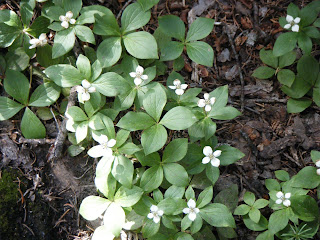First off, I would like to give a big THANK YOU to the Kiser family for loaning out their condo here in Silverthorne, Colorado. Thanks to these generous folks, my father and I have been able to explore the Rocky Mountains by day and relax in a warm, dry place complete with all the amenities, not to mention some nice luxuries like a pool and hot-tub! Now, if I just could have had a hot tub at the end of each day on the MST...ah well. This place is pretty special- the views from the condo alone are fabulous...
Each day, my father and I have tackled a different trail across these mountains, all over 10,000 ft high. The first day, we took on Buffalo Mountain, literally in our backyard. This trail started out easy, winding through thick evergreen woods. The evergreens here are entirely different from those we have out East. I'm getting to know Lodgepole Pine, Engleman Spruce, and White Spruce. What amazed me the most was how much understory growth there was even admist these pines. We passed Lupine and thick clusters of Fleabane, Heart-leaved Arnica, and Bunchberry, speckled admist these were Parry's Bellflower, Pink Wintergreen, Sickletop Lousewort, and Twinflower.
The climbing soon began, and our eyes searched the rocky terrain for cairn (purposely placed piles of stones) marking the way. To our left we gasped at the sweeping views of the valley below. We spied the rooftop of our condo, the Dillion Reservoir, and the unknown mountains beyond.
This trail was challenging, especially with shortened breath. Only 2 days into this high altitude, we found ourselves with more labored breathing and thus a mild feeling of headiness. We had begun at 10,000ft and were at this point somewhere around 12,000ft. But the real challenge came when we hit the boulder field that climbed straight up the side of the mountain to the tippidy-top. If we had been searching for the trail before, now we were simply climbing our way up, remarking happily when we actually saw a pile of stones that might resemble a marker. We went up and up and moved slower and slower. Turning about face, we were dizzy with height. All around the mountains towered in the distance and below, the valley appeared like that seen from an ariel view. Literally dizzy with altitude, we decided the boulder field to the top might be a bit much to take on and some headed back to more level ground for lunch.
Just some hundred feet lower, I felt more grounded and so thought I'd take another stab at scrambling up the rocks. I made it up to about the same spot when I again began to feel as if I were weightless, teeter-tottering above the earth. The summit of Buffalo Mountain would have to wait for another day. However, just as I was about to head back down, I spied an object atop a flat slab of rock I had not seen there before. Was it a rock cairn? Or a person? I waved my arms to see if they responded. I craned my head this way and that. Nada. Must be rocks. But just then...the rocks moved, revealing a silhouette of four legs, long hair, and two horns...a mountain goat! I scrambled back down the rocks as fast I could to get my Dad and there we sat at the bottom, spying up close 3 mountain goats, with the help of his binoculars. We watched for a long time until the very last one laid down atop the rock and could be seen no more.
Besides the mountain goats, we also had the pleasure of glimpsing the rear end of several Pika. These are little guinnea pig-like creatures that seem to live in the crevaces of the rocks and let out quite the “peeeek!” when startled. The chipmunks here are also rather unusual, rather small and with very pointed ears. They scurry about but do not seem to have the same fear of humans as those back home.
3000ft in 2.8m up Buffalo Mountain, gave me an appropriate respect for these massive mountains. However with each hike (coming up in following posts!) I have adjusted to the altitude, summiting Mount Sniktau at over 13,000ft without problem just a couple of days later.
Thank you, Colorado.










No comments:
Post a Comment